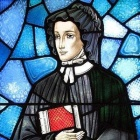St Elizabeth Seton, St Rigobert

St Elizabeth Seton
Wife and foundress. She was the first native-born American woman to be canonised. Born in New York in 1774 to a prominent Episcopalian family, her father Richard Bailey, was a professor of anatomy. At 20 she married William Seton, an import-export trader. Their marriage was a happy one and they had five children, but in 1803, Richard died.
Elizabeth became a Catholic in 1805 and founded a religious order, the American Sisters of Charity, based on the rule of St Vincent de Paul, devoted to the relief of the poor and school teaching. She spent the rest of her life to leading and caring for her community.
She has been described as a 'charming and cultivated woman of determined character'. Elizabeth died near Baltimore in 1821 and was canonised in 1975 by Pope Paul VI.
During the canonization service, which was attended by more than 1,000 sisters from north and south America, the Pope stressed her extraordinary contribution as wife, mother, widow and consecrated nun, the example of her dynamic and authentic witness for future generations and the affirmation of that 'religious spirituality which your (i.e. America's) temporal prosperity seemed to obscure and almost make impossible.'
Read more about St Elizabeth Seton: https://en.wikipedia.org/wiki/Elizabeth_Ann_Seton
and St Rigobert
This 8th century French Benedictine archbishop, is also known as Saint Robert of Rheims. After serving for a time as abbot of Orbais, he was appointed archbishop of Rheims. He was known for his kindness and ascetic nature. While bishop he lived in a small chamber over the city gates and had a ladder installed so he could easily get into the church to pray.
As a result of a dispute with Charles Martel, the powerful Frankish mayor of the palace, he was banished for a time and another bishop was appointed. When the matter was resolved Rigobert returned to Rheims, but to prevent scandal and dissention among the faithful, he did not try to recover his bishopric and instead became a hermit in a nearby village.
Rigobert was long venerated as a model of patience and was credited with many miracles. One story describes how he was given a live goose to take home for his dinner. Rigobert put the bird in the arms of a servant-boy accompanying him. Along the way, as Rigobert was reciting the Divine Office, the bird broke free and flew away. The boy was very concerned about this mishap, but Rigobert comforted him, urging him to trust in God. When Rigobert resumed his prayers, the goose flew back to them. Thereafter, the archbishop kept the bird as a pet. The goose would walk with him to church, and wait patiently for him while he celebrated Mass at an altar dedicated to the Virgin Mary.
Rigobert died 743 and was buried in the Church of Saint-Thierry in Rheims.












